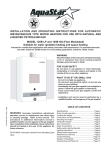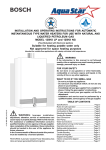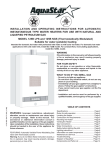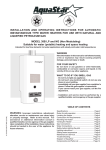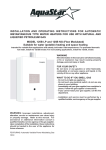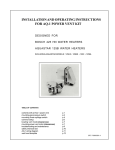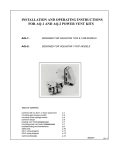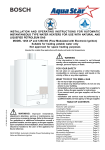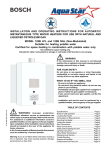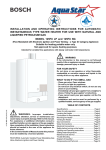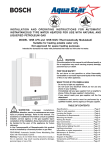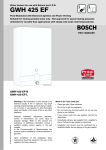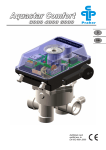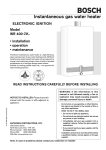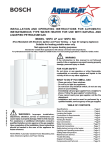Download AquaStar 125X NG Operating instructions
Transcript
INSTALLATION AND OPERATING INSTRUCTIONS FOR AUTOMATIC INSTANTANEOUS TYPE WATER HEATERS FOR USE WITH NATURAL AND LIQUEFIED PETROLEUM GAS MODEL 125X LP and 125X NG (Flow Modulated with Electronic Ignition) Suitable for water (potable) heating and space heating Intended for variable flow applications with steady cold water inlet temperatures. For preheated domestic hot water, install the 125 BS model. WARNING If the information in this manual is not followed exactly, a fire or explosion may result causing property damage, personal injury or death. FOR YOUR SAFETY Do not store or use gasoline or other flammable, combustible or corrosive vapors and liquids in the vicinity of this or any other appliance. WHAT TO DO IF YOU SMELL GAS - Do not try to light any appliance. - Do not touch any electrical switch; do not use any phone in your building. - Immediately call your gas supplier from a neighbor’s phone. Follow the gas supplier’s instructions. - If you cannot reach your gas supplier, call the fire department. - Installation and service must be performed by a qualified installer, service agency or the gas supplier. 6 720 605 566 PT 961 (01.99) TABLE OF CONTENTS WARNING : Improper installation, adjustment, alteration, service or maintenance can cause injury or property damage. Refer to this manual. For assistance or additional information consult a qualified installer, service agency or the gas supplier. Upon completion of the installation, these instructions should be handed to the user of the appliance for future reference. FEATURING: Automatic Variable Power Modulating Gas Valve and Electronic Ignition Specifications .................................................... Page 2 Rules for safe operation .................................... Page 4 Locating the Heater ........................................... Page 5 Combustion Air Requirements ........................... Page 5 Mounting the Heater .......................................... Page 6 Venting the Heater ............................................. Page 6 Gas Connections ............................................... Page 7 Water Connections ............................................ Page 8 Safety before turning on the heater ................... Page 8 Operating instructions ........................................ Page 9 Setting water temperature ................................. Page 9 Maintenance & Service .................................... Page 10 Trouble Shooting ............................................. Page 10 Microswitch Adjustment ................................... Page 11 Electrical Diagram ........................................... Page 12 Diagram of AquaStar ....................................... Page 13 Interior components diagram ........................... Page 14 Parts List ......................................................... Page 15 Principle of Operation: When a hot water faucet is opened, the water flow through the heater causes the gas valve to open. At the same time a microswitch is activated which sends a spark to the pilot. The flame sensor confirms the pilot has been lighted and allows the first two burners to come on. The flame sensor confirms correct activation and all burners come on. The pilot goes off. The heat exchanger coils absorb the heat generated by the burners and transfer heat to the water. When the hot water faucet is shut off, the gas valve automatically closes and the burners turn off. Your hot water faucet is an ignition key to activate the water heater, giving you control over your hot water energy use. Every time you turn off your hot water faucet, the energy consumption of your hot water returns to zero. AquaStar 125X LP and 125X NG Specifications Gas Input max.: 117,000 Btu/hr min.: 28,000 Btu/hr Water Connection 1/2” Thread fitting H x W x D 29 3/4” x 18 1/4” x 8 3/4" Vent 5” Gas Connection 1/2” NPT thread Min. Water Pressure 18 Psi at 4 GPM Max. Water Pressure 150 Psi FEATURES Shipping Weight 43 LB - Electronic Pilot Ignition Net Weight 40 LB - High Quality Materials for Long Working Life. - Copper heating coils for endless supply of hot water. 1.8 GPM at 90° rise 3.7 GPM at 45° rise - Burner output proportional to hot water flow demand for maximum energy efficiency. Min. Water Flow 1/2 gal/min - Safety flame sensor at pilot burner. LP GAS Supply Pressure inlet. min. 11” W.C. max. 14” W.C.* - Automatic overheating protection shut-off sensor. LP GAS Manifold pressure 9.0” W.C.** - Stainless steel burners with stabilized blue flame. - Built-in corrosion resistant draft inducer. Natural Gas Pressure inlet max.: 14” W.C.* min.: 7” W.C. - Compact space saver: mounts on a wall with two hooks. Natural Gas Manifold Pressure 4.2 W.C.** - Easily removable one-piece cover. * Inlet gas pressure must not exceed this value - Easy one person installation. ** For purposes of input adjustment - Adjustable water flow restrictor to ensure that water flow demand will not exceed the heating capacity of the heater. - Electronic Pilot Ignition - Safety Flame Sensor at pilot burner (not thermocouple) - On/Off Switch to activate system - LED indicator flashes before battery needs replacement UNPACKING THE AQUASTAR HEATER This heater is packed securely. The box includes two water connection fittings, a gas pressure regulator, an incandescent particle tray, two hooks for hanging the heater, this manual, a personal letter, a warranty statement and a warranty registration card. Do not lose this manual, as there is a charge for replacement. Please complete and return the enclosed warranty registration card. 2 D870_072 FRONT VIEW SIDE VIEW MINIMUM INSTALLATION CLEARANCES FROM COMBUSTIBLE AND NON COMBUSTIBLE MATERIALS FOR ALCOVE INSTALLATIONS MODEL 125B / 125B LOW PRESSURE / 125B SOLAR / 125 X TOP (A) FRONT (B) BACK SIDES FLOOR (C) FLUE DIAMETER 12" OPEN 0" 4" 12" 5" AQUASTAR MODELS 125B / 125BL / 125BS / 125X 3 If you are using the AquaStar for combined space heating and potable water heating (see schematic diagram below), all piping and other components connected to the system must be suitable for potable water, (b) toxic chemicals such as those commonly used for boiler treatment to prevent corrosion and freezing must not be introduced into the system, and (c) if the space heating requires water temperatures higher than those required for domestic, potable water, a mixing valve or other similar device must be provided to reduce scald hazard potential, (d) maximum system water temperature must not exceed 140°F (60°C). DO NOT CONVERT AN EXISTING, CLOSED HOT WATER HEATING SYSTEM TO A COMBINATION SPACE AND POTABLE WATER HEATING SYSTEM USING THE AQUASTAR OR ANY OTHER HEAT SOURCE. Open loop potable water and combination space heating system* * To be used with a tank, check local codes. May not be permitted in some jurisdictions. 1. Maximum operating temperature of 125X: 130°F 2. Maximum heating capacity: 60°F rise 30°F rise 70,000 BTU/hr 35,000 BTU/hr 3. System shown is electric storage tank with recirculating supply drawn from the tapping for the lower heating element. 4. Schematic is for illustration and example only and must not be used for actual installation without appropriate engineering and technical advice from a professional properly licensed in the locality where the installation is made. GENERAL RULES TO FOLLOW FOR SAFE OPERATION 1. You should follow these instructions when you install your heater. In the United States: The installation must conform with local codes or, in the absence of local codes, the National Fuel Gas Code ANSI Z223.1/NFPA 54. In Canada: The Installation should conform with CGA B149.(1,2) INSTALLATION CODES and /or local 4 installation codes. 2. Carefully plan where you install the heater. Correct combustion air supply and flue pipe installation are very important. If not installed correctly, fatal accidents can be caused by lack of air, carbon monoxide poisoning or fire. 3. The place where you install the heater must have enough ventilation. The National Fire Codes do not allow water heater installation in bathrooms, bedrooms or any occupied rooms normally kept closed. See the section below on locating the heater. through the flue. Confirm that your Aquastar is venting properly when all these other appliances are running. See section on venting. 4. You must vent your heater. See section on Vent Pipe Connections, Page 6. Do not obstruct the flow of combustion and ventilation air to the appliance. If installed near a clothes dryer it is very important that the dryer be properly vented. Failure to properly vent a dryer could result in a gradual accumulation of lint on the water heater fin coils and burners, leading to a dangerous condition of venting blockage and poor unsafe combustion. 5. The appliance must be disconnected from the gas supply piping system during any pressure testing at pressures in excess of 1/2 Psig (3.5 kPa). The appliance must be isolated from the gas supply piping system by closing its individual manual shutoff valve during any pressure testing of the gas supply piping system at test pressures equal to or less than 1/2 Psig (3.5Kpa). The appliance and its gas connection must be leak tested before placing the appliance in operation. 6. Keep water heater area clear and free from combustibles and flammable liquids. Do not locate the heater over any material which might burn. 7. Correct gas pressure is critical for the optimum operation of this heater (see specifications on page 2). Gas piping must be sized to provide the required pressure at the maximum output of the heater, while all the other gas appliances are in operation. Check with your local gas supplier, and see the section on connecting the gas supply. 8. Should overheating occur or the gas supply fail to shut off, turn off the gas supply at the manual gas shut off valve on the gas line. 4. Your hot water lines should be kept short to save energy. It is always best to have hot water lines insulated. Having a floor drain or sink nearby is handy in case you need to drain water from your heater. WARNING: The water in this water heater is cold and always remains cold except for the times that hot water is being used DO NOT INSTALL IN AN AREA WHERE IT COULD FREEZE. This heater is neither designed for nor approved for outside installation. WARNING: Flammable materials, gasoline, pressurized containers, or any other items or articles that are potentially fire hazards must NOT be placed on or adjacent to the heater. The appliance area must be kept free of all combustible materials, gasoline and other flammable vapors and liquids. COMBUSTION AIR REQUIREMENTS 9. Do not use this appliance if any part has been underwater. Immediately call a qualified service technician to inspect the appliance and to replace any part of the control system and any gas control which has been underwater. PROPER LOCATION FOR INSTALLING YOUR HEATER Carefully select the location of your new heater. For your safety and for proper heater operation, you must provide an abundant supply of combustion air and a proper venting installation. The heater may still operate even when improperly vented. It will, however, be less efficient and could eventually damage the heater. It could even result in human sickness or death due to oxygen deprivation and carbon monoxide poisoning. Follow the guidelines below: 1. Place your heater as close to a vent or chimney as possible. 2. National building codes require that you do not install this appliance in bathrooms, bedrooms or any occupied rooms normally kept closed. 3. Simultaneous operation of other appliances such as exhaust fans, ventilation systems clothes dryers, fireplaces or wood stoves could create a vacuum effect in your home which could cause dangerous combustion by-products to spill back into your home rather than venting to the outside Observe the following instructions concerning combustion air. Appliances located in unconfined spaces: a) An unconfined space is one whose volume is greater than 50 cubic feet per 1000 Btu per hour of the combined rating of all appliances installed in the space. That would be 5850 cubic feet for the AquaStar 125X alone. b) In unconfined spaces in buildings of conventional frame, masonry, or metal construction, infiltration is normally adequate to provide air for combustion, ventilation, and dilution of flue gasses. Appliances located in confined spaces:) The confined space must be provided with two permanent openings, one commencing within 12 inches of the top and one commencing within 12 inches of the bottom of the enclosure. Each opening must have a minimum free area of one square inch per: - 1000 Btu/hr if all air is taken from inside the building. - 2000 Btu/hr if all air is taken from the outside by horizontal ducts. - 4000 Btu/hr if all air is taken from the outside by direct openings or vertical ducts. Louvers, grills and screens have a blocking effect. If the effective free area is not known, increase the sizes of your openings by 75% if your louvers are wood and by 30% if your louvers are metal. Refer to the National Fuel Gas Code for complete information. In buildings of tight construction all air should be taken from outside. 5 CLEARANCES The Aquastar 125 X is design certified for installation on a combustible wall and for installation in an alcove with the minimum clearances to combustible and non -combustible construction listed below A. Top 12 inches ( 305 mm) B. Front Open C. Back 0 inches D. Sides 4 inch (102mm) E. Bottom 12 inches (306 mm) The incandescent particle tray (shipped loose in the carton with the water heater) must be attached at the bottom of the water heater front cover at the time of installation. Use the screws provided. See figure 2 SCREWS INCANDESCENT PARTICLE TRAY Clearance from vent is dependent upon the clearance rating of the venting material used. For example: type B-1 vent is approved for 1 inch clearance, B-2 vent for 2 inch, etc. Note: Minimum clearance to combustible materials should not be less than 6" for single wall flue pipe. Note that this clearance can be reduced if combustible material are protected as per table VI of the National fuel Gas Code or if Type B gas vent is used. MOUNTING INSTALLATION The Aquastar 125 X is design certified for mounting on a wall. Do not install this appliance on a carpeted wall or over floor covering which is combustible, such as carpet. The heater must be mounted on a wall using appropriate anchoring materials. If wall is a stud wall sheathed with plasterboard, it is recommended that support board(s), either 1x4’s or 1/2" (minimum) plywood first be attached across a pair of studs and then the heater should be attached to the support boards. See Fig 1. Expansion and contraction of piping due to changing water temperature in the pipes imparts movement to the heater which, if mounted directly to a brittle, friable board, such as plasterboard, can cause failure of mounting. Before installing the unit, be certain you have the correct heater for your type of Gas – Propane or Natural Gas. Identification labels are found on the shipping box, and on the rating plate which is located on the right side panel of the cover. Also, each burner orifice is stamped with a number (79 for LPG and 120 for Natural Gas). WALL STUDS 13 ¼” SUPPORT BOARD 1” X 4” SPACE BOARD Fig. 1 - Mounting the Heater 6 Fig. 2 - Incandescent Particle Tray Illustration VENTING Vent pipe connection. WARNING: Do not reduce the vent pipe size. This appliance must be vented to the outside following all local ordinances and specifications for installing a gas appliance vent or chimney. The venting system must be designed and constructed so as to develop a positive flow adequate to remove flue gasses to the outdoors. Minimum vent size must be 5". Minimum vent height must be 6 feet, provided there are no elbows. Termination of the vent must be 2 feet above any obstruction within a 10 foot radius of the vent pipe. Consult your gas utility or National Gas Fuel Code if vent will have elbows or share venting with another appliance. The vent connector should have as much vertical rise as possible (minimum 12”) before any horizontal run. Optional powervent available in order to sidewall vent. Contact your local dealer. The appliance must be located as close as practicable to a chimney or vent. The vent pipe sections must be secured to each other with sheet metal screws. Keep in mind the minimum clearance from the top of your heater. Remember also that single wall vent pipe connectors require a 6 inch clearance from combustibles. National Fuel Gas Code specifies double wall — Type “B” — vent pipe be used in cold climates and for gas vents running through attics. We consider double wall vent pipe preferable in all circumstances. Any vent section greater than 45 degrees from vertical is considered horizontal. Horizontal sections of vent connectors must slope upwards at least 1/4 inch for every foot of its horizontal length. Keep the horizontal section short and avoid too many elbows. WARNING Note: The burners of an instantaneous “on demand” water heater such as the AquaStar are only on at the time that hot water is actually being used, the venting stack is therefore cold except for the short durations when hot water is being used, it is therefore very important that the venting and air supply be adequate to provide a good positive draft as soon as the burners turn on. See venting guide on back page. The AquaStar 125X instantaneous water heaters have built-in draft diverters and are designed for indoor installation only. The draft diverter outlet must be connected to a clear, unobstructed vent of the same size, or larger. In Canada, CAN/CGA-B149 Installation Code for detailed requirements In U.S.A., ANSI Z223.1 - NFPA 54, national Fuel Gas Code for detailed requirements. The flue connection for the AquaStar 125X is 5 inches. However, in Canada, for installations at high altitude (20004500 feet above sea level) a six inch flue is required. A 5" by 6" flue adaptor must be affixed to the flue collar of the AquaStar with at least two screws. See figure 3. WARNING: Failure TO INCREASE THE VENT SIZE TO SIX INCHES AND/or assure that the manifold pressure is set to proper value listed for applications at high altitudes will cause unsafe venting, asphyxiation, and will void IAS Certification. (660 meters) above sea level. On appliances being installed above 2000 ft (660 meters) elevation, the inlet gas pressure should be set at installation to the value shown below. NOTE: The gas pressures specified below refer to pressures taken at the test pressure nipple on the gas inlet pipe just above the regulator (See Fig 4). These readings should be taken while the heater is operating at full input — i.e. maximum water flow with the temperature dial selector turned all the way clockwise. MAXIMUM INLET GAS FLOW PRESSURE SETTING 5” X 6” ADAPTOR USED ON HIGH ALTITUDE Altitude 0' - 2.000 ft 2.000 ft - 4.500 ft Natural Gas inches W.C: 5.7" 4.6" Liquid Propane inches W.C: 10.5" 8.4" Above 4.500 ft consult your local gas provider. GAS LINE SIZE Fig. 3 - Flue Adaptor for High Altitude Installations GAS CONNECTIONS and Gas Regulator Before connecting the gas supply, check the rating plate on the right side of the front cover to be sure that the heater is rated for the same gas to which it will be connected. In the United States: The installation must conform with local codes or, in the absence of local codes, the National Fuel Gas Code ANSI Z223.1/NFPA 54. In Canada: The Installation should conform with CGA B149 INSTALLATION CODES and /or local installation codes. NOTE: The Aquastar 125 X is supplied with a gas pressure regulator that must be installed on the heater before attaching the gas supply line. See figure 4. Failure to install the gas regulator as shown in figure 4 will be a violation of IAS certification of the unit. The regulator supplied with the heater is preset for the gas shown on the rating plate to the correct pressure. It is an appliance level regulator designed for (low inlet) pressure (less than 1/2 Psig or 15” W.C.) DO NOT connect to an unregulated or high pressure propane line or to a high pressure commercial natural gas line. GAS INLET PIPE PRESSURE TAP PRESSURE REGULATOR Fig. 4 - Installation of Gas Pressure Regulator The pressure regulator provided with the heater is adjusted to deliver the proper gas pressure (as indicated on the rating plate and in the manual for altitude up to 2000 feet It is strongly recommended that the natural gas pipe line be 3/4" for the entire distance. If the maximum length is above 40 feet, use 1" line. Flexible tubing is NOT recommended, but if it is to be used, oversize it. With LP gas installation, the recommended sizes are 5/8" up to a maximum of 20 feet distance, 3/4" up to 50 ft distance and 7/8" up to 100 feet. National Fuel Gas Code requires that a sediment trap (drip leg) be installed on gas appliances not so equipped. The drip leg must be accessible and not subject to freezing conditions. Install in accordance with the recommendations of the serving gas supplier. WARNING: The heater must be disconnected from the gas supply piping system during any pressure testing of that system at test pressures in excess of 0.5 psig. The water heater must be isolated from the gas supply piping system by closing the manual shutoff valve during any pressure testing of the gas supply piping system at test pressures equal to or less than 0.5 psig. The water heater, including the pressure regulator provided with it, must not be operated at gas supply pressures in excess of 0.5 psig. If overpressure has occurred, such as through improper testing of the gas lines or emergency malfunction of the supply system, the gas valve and regulator must be checked for safe operation. Make sure that the regulator vent is protected against blockage. Vent blockage could occur during ice storms. When your connections are made, check for gas leaks at all joints (not just the ones you made). Apply some soapy water to all gas fittings and gas valve. Soap bubbles are a sign of a leak. NOTE: Do not apply soap solution to pilot filter screen or pilot orifice area. If you have a leak, shut off the gas. After verifying that required gaskets are in place, tighten appropriate fittings to stop leak. Turn the gas on and check again with a soapy solution. Never test for gas leaks using a match or flame. 7 WATER CONNECTIONS OPERATING INSTRUCTIONS Although water piping throughout your structure may be other than copper, we recommend that copper piping be used for at least three feet before and after the heater (follow local codes if more stringent). Keep water inlet pipe to no less than 1/2 inch diameter to allow the full flow capacity. Remember that water pressure must be sufficient to activate the heater when drawing hot water from the top floor. If the hot and cold connections to the heater are reversed, the heater will not function. The AquaStar 125X is provided with two connectors that must be connected to the inlet and outlet fittings of the water valve as shown in Fig 5. These fittings seal to the water valve by means of a union connection with a washer type gasket at the joint. No pipe dope or thread tape is to be used at these joints. Be certain there are no loose particles or dirt in the piping. Blow out or flush the lines before connecting to the AquaStar. A ball valve should be installed on the cold water feed line to facilitate servicing the heater. For installation on a private well system, be sure that the water pressure is set between 30 and 50 psi. Before proceeding with the operation of the heater make sure that the system is filled with water. Make sure the water heater drain plug is closed. See Figure 7 below. Fig. 7 - Water heater drain plug Open the cold water inlet supply to the heater fully. Open a hot water faucet to permit the water to fill the heater and the piping and to eliminate the air trapped in the system Close the hot water faucet after the water flows freely and all the air has escaped from the system. The water heater is now ready to work FOR YOUR SAFETY READ BEFORE OPERATING YOUR HOT WATER HEATER Warning: If you do not follow these instructions exactly, a fire or explosion may result causing property damage, personal injury or loss of life. Fig. 5 - Water valve - top view Connecting the pressure relief valve (PRV) A listed pressure relief valve supplied with the heater must be installed at the time of installation. No valve is to be placed between the PRV and the heater. No reducing coupling or other restriction may be installed in the discharge line. The discharge line must be installed such that it allows complete drainage of both the PRV and the line. The location of the PRV must be readily accessible for servicing or replacement., and be mounted as close to the water heater as possible. See Fig 6. To install the PRV, a suitable fitting connected to an extension on a “T” fitting can be sweated to the hot water line. CW S HW S P res s ure R e lief Va lve Fig. 6 - Pressure Relief Valve 8 A. This appliance is equipped with electronic ignition for lighting the pilot and main burners. When turning the heater on, follow these instructions exactly. B. Before operating the unit, set the On/Off switch to the On (I) position. The On/Off switch is located behind the flip-down coverplate on the front panel strip. Smell all around the appliance area for gas. Be sure to smell next to the floor because some gas is heavier than air and will settle on the floor. WHAT TO DO IF YOU SMELL GAS - Do not try to light any appliance. - Do not touch any electric switch; do not use any phone in your building - Immediately call your gas supplier from a neighbor’s phone. Follow the gas supplier’s instructions. - If you cannot reach your gas supplier, call the fire department. C. Use only your hand to push in the on/off control button. Never use tools. Follow these instructions exactly. If control button is jammed, close the gas supply and call a qualified service technician. Attempted forceful repair may result in a fire or explosion. D. Do not use this appliance if any part has been under water. Immediately call a qualified service technician to inspect the appliance and to replace any part of the control system and any gas control which has been under water. LIGHTING AND OPERATING INSTRUCTIONS 1. STOP! Read the safety information above on this label. 2. The gas valve must be shutt off by putting the ON/OFF switch to position “0”. Wait five (5) minutes to clear out any gas. If you smell gas, STOP! Follow “B” in the safety information above. If you do not smell gas, go to the next step. 3. This water heater is equipped with a safety pilot burner and an automatic ignition control system. 4. Set the ON/OFF switch (flip down cover plate on frontal panel strip) marked I/0 to the I position. In this position, the water heater is ready to use. 5. If the red LED indicator light (visible through the peephole in the front panel strip) is flashing, this is a warning that the batteries are less than 1.2 Volts and will need to be replaced within the next couple of weeks. Plan to have two D type 1.5 volt long-life (Alkaline) batteries available for replacement. 6. Turn the hot water faucet on the minimum flow rate required to activate the heater. The automatic ignition system first ignites the safety pilot burner which then ignites the main burner in about 4 seconds. 7. The pilot flame will extinguish 10-30 seconds after the burners come on. The burners will remain on until the hot water tap is turned off. NOTE: On a first time initial installation, existence of air in the gas supply line and in the water line may cause some ignition delay. In that case, repeatedly open and close the hot water tap in order to restart the ignition process until all the air has been purged. TO TURN OFF GAS TO APPLIANCE Turn off the manual lever on the gas supply line to the heater and set the ON/OFF switch to the OFF ( 0 ) position. T E M P E R AT U R E ADJU STM E N T KNO B Fig. 8 - Temperature Adjustment Knob What is the best temperature setting? Because AquaStar water heaters deliver endless hot water at the temperature you have selected, there is no need to produce very hot water and then mix in cold. It just does not make sense to overheat water and then mix in cold to cool it off. You cannot run out of hot water with an AquaStar, so set the dial for the temperature you prefer . Note: 105°F is the maximum recommended for a hot bath. The position you select on the temperature adjustment knob will depend on the temperature of the incoming water (50°F is average in the U.S.). In warm weather regions where the incoming cold water is generally warmer, or during the hot weather months in some other areas a midway setting on the temperature adjustment knob would produce a temperature rise of about 70 ° F, giving an output of approximately 120°F. At this setting, if it is still necessary, one could mix a small amount of cold water in a shower and have a comfortable shower at about 3 gallons/minute. During the colder months, or in cold climate areas, it might be necessary to set the control to the maximum position, all the way clockwise to the right. If you supply the AquaStar 125X, with preheated water (i.e.) in a solar installation the unit could overheat. It will then shut off on safety when the outlet temperature reaches 194°F. For this type of application, purchase a solar model 125B LPS or 125B NGS. Align batteries as shown If the LED light is flashing, prepare to replace the batteries. Use two D cell (1.5 volt) long life alkaline batteries. G667_090 To operate the heater, set the ON/OFF switch to position I. The switch is located behind the flip down cover plate on the front panel strip. To shut down the gas to the heater, set the ON/OFF switch to position 0 G667_091 Temperature Adjustment Knob Decrease temperature and increase flow Increases temperature and decreases flow G661_004 The AquaStar 125 X LP and 125 X NG water heaters have a gas control that modulates burner input in response to flow. Its purpose is to ensure that the hot water temperature will remain steady, although the water flow demand might vary (down to 1/2 gal/minute). To adjust the temperature on your AquaStar, turn on a hot water faucet to its maximum flow. At the water heater, turn the large knob located beneath the main gas control on the front of the heater all the way to the right (clockwise). See Fig 8. This will produce a temperature rise of approximately 90°F at flow rates between 0.5 and 2.0 gallons per minute. Given that average incoming water temperatures are 50°F, this heater will produce approximately 140°F water at these flow rates. Turning the dial all the way to the left (counterclockwise) will produce a temperature rise of approximately 45°F for flow rates between 1.1 and 3.7 gallons per minute. It is safest to select a comfortable temperature and not have to mix in cold water. G667_092 SETTING THE WATER TEMPERATURE Fig. 9 - Principles of Operation 9 MAINTENANCE AND SERVICE Approximately once a year, the AquaStar should be checked, cleaned and serviced as necessary. To remove the front cover, first remove the incandescent particle tray, then pull off the temperature adjustment knob and unscrew and remove the plastic collar. Pull main cover out toward you and lift up and out. THE FOLLOWING OPERATIONS SHOULD BE PERFORMED BY A QUALIFIED SERVICE PERSON: Do not use any wire or sharp object to clean orifices. Natural gas orifices are large enough that you can usually clean them by blowing through them. LP orifices, on the other hand, are too small to clean and should be replaced. To access the pilot orifice, remove 2 screws holding pilot assembly in place. Then loosen compression fittings to expose pilot orifice. Vent System: Should be checked annually. Clean and repair as needed. Water Valve (Part # 8707002499): The water valve on this heater should be serviced periodically The frequency will depend on the mineral content of the water and conditions of use or whenever signs of corrosion appear at the gas and water valve joint. Check that the water inlet filter (#28 on Figure 14, page 14) is clean. PILOT ORIFICE Pilot Flame: The pilot flame should burn with a clean, sharp, blue flame and should resemble the diagram in Fig.10. If the flame is soft and yellow, the pilot burner orifice may need to be cleaned or replaced. The pilot flame should be approximately 2 inches long, extending past the flame sensor. If the flame is too small, it will not reach the flame sensor and the burners will not come on. 3mm Correct gap between pilot burner tip and electrode tip Fig. 11 - Pilot burner with pilot orifice Main Burner Flames: The main burner flames should be blue, with a more intense blue cone in the center core. Yellow flames could be a sign of wrong size gas orifices or dirty burners, or a blockage on the heat exchangers fins. If some burners have yellow flames while others have good flames, it is likely that dust, lint or spider webs have partially clogged the burner venturis. To clean the burners, contact a gas service person. Mineral Scale Build-up: AquaStars, when operated at lower temperature settings, tend not to accumulate mineral buildup. If however, the heater is used at the higher temperature settings and the water has a high mineral content, periodic descaling may be necessary. The heating coils should be flushed with a descaling solution. Consult your dealer or Controlled Energy for instructions. Piezo Electrode TROUBLE SHOOTING Flame sensor Piezo Electrode Fig. 10 - Characteristic Pilot Flame To clean the pilot burner and/ or the pilot orifice : Turn off the gas to the unit. Set the On/Off switch to Off (position 0). Remove the cover of the heater. To do so, pull off the temperature adjustment knob and unscrew and remove the plastic collar. Pull main cover out toward you and lift up and out. The pilot orifice should be cleaned or replaced. Do not enlarge the orifice. 10 Introduction The AquaStar 125X burners are activated by a water flow valve. Numerous water related problems can cause this water valve to malfunction such as: Insufficient water flow volume to activate the burners at its minimum flow requirement; Dirt in the water flow valve causing it to malfunction; Sediment build-up in faucet aerators, or shower heads; Uneven pressures between cold and hot. (with single lever faucets) Plumbing cross overs. These water flow related problems can cause the heater to deliver less than its full output, or to fail to ignite or to shut down completely. Problems are stated in upper case, bold face. Most common causes for the problems follow in order of likelihood. The suggested solutions require that the cover be taken off. To do this, remove incandescent particle tray, pull off the temperature adjustment knob and unscrew and remove the plastic collar. Pull main cover out toward you and lift up and out. NO SPARK AT THE PILOT 1. On/Off switch is not ”On” (Position I). The On/Off switch is located behind the flipdown cover plate on the front panel strip. See fig. 9. 2. Water flow is not sufficient to activate heater. Water flow rate at faucet is below minimum flow needed to activate heater. When temperature adjustment knob is turned all the way clockwise, the AquaStar model 125X requires 1/2 gallon per minute flow to activate the heater. As a reference, this is a flow which would fill a quart jar in 30 seconds. If the temperature adjustment knob is turned fully counterclockwise, a flow rate of 1.1 gallons/minute is required to activate the heater. 3. Water inlet filter is clogged Water flow is restricted, preventing needed flow to activate heater. Clean water inlet filter screen. 4. Cross over in water lines To confirm there is no cross-over in the plumbing, shut off the cold water supply to the AquaStar water heater and open a hot water faucet. There should not be any water flowing at that faucet. Water running is a sign of a plumbing cross-over. Consult your plumber. 5. Batteries are weak The LED light (seen through the peephole in the coverplate on the front panel) flashes when the batteries are less than 1.2 volts. Replace batteries with D cell (1.5 volt) long life alkaline batteries as shown in fig. 9. 6. Microswitch needs to be adjusted or replaced. If you do not hear a click when a tap is opened, the microswitch needs to be adjusted. See Fig. 12 for adjustment, or replace the microswitch if the heater has been in use for some time. 7. Cold incoming water connection made to wrong side of heater Make sure cold water inlet connection is on the right side of heater when you are facing heater. 8. Water valve parts may be dirty or components damaged First check that venturi is free of dirt particles. Water valve and component parts must be totally free of dirt. In hard water areas, mineral deposits can eventually (3-5 years in hard water areas) corrode the water valve parts to a point where they will need replacing. Any sign of moisture at the bleed hole is a sign that the water valve components need to be replaced immediately. 9. Loose connection at the ECO Ignition sparker will not operate if the electrical circuit is interrupted. Check that the connections to the ECO are secure and tighten if necessary. SPARKS APPEAR AT PILOT WHEN HOT WATER TAP TURNED ON, BUT PILOT AND BURNERS WILL NOT IGNITE 1. Air in the Gas Line Normally this is a problem at time of initial installation, after the pipes have been worked on, or after a gas supply line has been allowed to empty. Bleed the air trapped in the gas line by turning the hot water faucet on and off until the air has been cleared from the line. 2. No gas to the AquaStar A. Gas cock on gas line may not be open B. Gas regulator may be shut or damaged. Replace or unjam the regulator. Note: The regulator furnished with the heater is exclusively designed for low gas pressure. Excessive pressure will lock it up. Jamming usually happens when using propane gas if f the gas pressure between the gas tank and the water heater’s gas regulator has not been reduced. See Page 2 for recommended correct gas pressure. To unjam a regulator, consult your gas supplier or call CEC. 3. Pilot orifice or gas valve is dirty Clogging of the pilot burner can be caused by dust in the air or dirt in the gas. The pilot orifice or gas filter may need to be cleaned or replaced. G871_212 Adjusting screw Fig. 12 - microswitch adjustment Pilot does not spark with water flow 1 Close water tap 2 Remove screw cap and unscrew adjusting screw till sparking starts 3 Screw in turning one and half turns Pilot is always sparking without water flow 1 Close water tap 2 Screw in adjusting screw, till it stops sparking 3 Continue to screw in turning one and half turns more 4. Water valve assembly needs to be checked If the pilot orifice is clean, the water valve assembly should be checked. The adjustment screw on the water valve micro-switch may not be tight enough (Fig. 12). Remove central cap beneath micro-switch assembly, carefully loosen the adjustment screw until the pilot light ignites. At that point retighten the screw one and a half turns. 5. Pilot electrovalve switch may need to be replaced (See Fig 13). Call CEC. 6. Electronic Control Box may need to be replaced (See Fig 13). Call CEC. 11 PILOT SPARKS CONTINUOUSLY WITH NO WATER RUNNING 1. Microswitch needs adjustment If no water is running, but pilot electrode continuously sparks, the microswitch screw to the water valve needs adjustment. See Figure 12. 3. ECO (overheat sensor) tripped due to overheating 4. Minimum inlet pressure on well is inadequate Check the inlet water pressure. On a private well, raise the minimum pressure setting to 30 psi. Confirm that the pressure tank is not water logged. WATER IS TOO HOT PILOT LIGHTS BUT BURNERS WILL NOT COME ON 1. Confirm water valve assembly is working properly. 2. Confirm the flame sensor is in its proper position. 3. Confirm the burner electrovalve switch is functioning properly. Call CEC 4. The electrical Control Box (Fig. 13) may need to be replaced. Call CEC. 1. Temperature Selection too high Turn the temperature adjustment knob counter-clockwise (to the left) to lower the maximum water temperature. Note: This will increase the activation flow rate. 2. Inlet water temperature is too hot (as with solar preheated water or high ground water temperatures) Decrease gas pressure. Note: Only the Model “S” AquaStar should be used if the inlet water is preheated. WATER IS NOT HOT ENOUGH 1. Temperature selection too low. Change the setting. Turn the temperature adjustment knob clockwise (to the right). Note: This will decrease the activation flow rate. E661_002 2. Water flow through the heater is higher than the capacity of the AquaStar to heat it Reduce the flow demand at the faucet. See flow rates at specific temperature rises on page 2. Fig. 13 - Electrical wiring diagram 4 43 51 52 96 99 electronic control box pilot electrovalve pilot electrode flame sensor microswitch assembly on/off switch 114 115 116 119 gas control valve burner electrovalve battery compartment 1.5V D batteries (2) overheat sensor 3. Btu input is too low due to insufficient gas pressure It is extremely important for a tankless instantaneous water heater to have the right size gas line to obtain the correct gas pressure See specifications on page 2. Unlike storage tank water heaters, the burners of a tankless water heater must be very powerful to heat water instantaneously since they do this only at the time hot water is actually being used. It is therefore imperative that the gas pressure requirement be met exactly. Insufficient gas pressure will directly affect the water temperature at the time of usage. See page 2 for correct gas pressure settings and fig. 14 for locations where gas pressures are taken. 4. Btu input is too low due to insufficient gas supply Make sure your main gas line is fully opened. If using LP gas, be sure that the size of the propane tank is adequate to supply the required gas pressure. MAIN BURNERS GO OUT DURING HOT WATER USE 1. Flow rate diminished below activation rate 2. Unbalanced pressure in the water lines The added restriction caused by the AquaStar in the hot water system can result in uneven pressures between the cold and the hot. In such cases when mixing cold water at the tap, the lower hot water pressure may be overpowered by a much higher cold water pressure, which may cause the AquaStar burners to shut down. Make sure faucet aerators and showerheads are free of minerals and dirt. Do not add any flow restrictor to the shower head. 12 5. Cold water is mixing with the hot water between the AquaStar and the outlet Compare water temperature at outlet of the AquaStar (hold the AquaStar’s outlet pipe with your hand) and at the tap. If these two are very different, check for mixing valve or plumbing crossover (see “NO SPARK AT THE PILOT” paragraph #4). Where automatic “anti-scald” valves are required by code, lower the temperature setting on the AquaStar as much as possible and balance the pressure between cold and hot water after the AquaStar. 6. Parts in water flow valve are corroded so that the gas passage is not fully opening. Contact your service person or Controlled Energy. 2. Cold water is mixing with the hot water between the AquaStar and the outlet See #4 under “NO SPARK AT THE PILOT”. HOT WATER TEMPERATURE FLUCTUATES 3. Inlet water pressure is erratic due to inadequate supply water pressure or saturated pressure tank on well system Check the inlet water pressure. On a private well, raise minimum pressure setting to 30 psi. Confirm that the pressure tank is not water logged. 1. Unbalanced pressure in waterlines The added restriction caused by the Aquastar in the hot water system can result in uneven pressures between the cold and the hot. In such cases when mixing cold water at the tap, the lower hot water pressure may be overpowered by a much higher cold water pressure, which may cause the Aquastar burners to shut down. Make sure faucet aerators or shower heads are free of minerals. Do not add any flow restrictor to the shower head. Fig. 14 - Diagram 4. Gas pressure is too low See page 2 for correct specifications. of AquaStar 125 X 1 3 2 4 5 6 7 9 8 13 10 11 1. 2. 3. 4. 5. 6. Heat exchanger Pilot assembly Burner manifold gas pressure test nipple Main gas burner Pilot gas tubing Gas valve 7. 8. 9. 10. 11. 12. 13. Electronic control box Battery box on/off switch Temperature adjustment selector Microswitch Gas inlet gas pressure test nipple Led 12 13 Fig. 15 14 - INTERIOR COMPONENTS DIAGRAM AND PARTS LIST Fig. 15 INTERIOR COMPONENTS DIAGRAM AND PARTS LIST 125X 1 2 3 4 5 6 7 8 9 10 11 11 12 13 14 14 15 15 16 17 18 18 19 20 21 22 23 24 25 26 27 28 29 30 31 Front cover Temperature adjustment knob Plastic collar Back panel Draught diverter Heat exchanger Hot water pipe Washer Overheat sensor (ECO) Cold water pipe Main Burner Assembly Main Burner Assembly Washer for burner assembly Throttle disc Gas valve Gas valve Diaphragm switch Diaphragm switch Pilot burner assembly Electrode ignition group Injector pilot Injector pilot Pilot gas tube Washer Ignition unit Battery box Set of cables complete Water valve Cover Slow-ignition valve Diaphragm Water inlet filter Selector screw Volumetric water governor Venturi ¤ ¤ ¤ ¤ ¤ ¤ ¤ ¤ ¤ ¤ NG LPG ¤ LPG NG LPG NG LPG ¤ ¤ NG LPG ¤ ¤ ¤ ¤ ¤ ¤ ¤ ¤ ¤ ¤ ¤ ¤ ¤ 8 705 421 255 8 702 000 111 8 700 403 008 8 705 402 164 8 705 505 354 8 705 406 235 8 700 705 556 8 710 103 045 8 707 206 040 8 700 705 294 8 708 120 298 8 708 120 296 8 710 103 060 8 700 100 174 8 707 011 729 8 707 011 730 8 708 504 021 8 708 504 049 8 708 120 491 8 718 107 067 8 708 200 069 8 708 200 312 8 700 707 349 8 700 103 173 8 707 207 060 8 700 505 062 8 704 401 035 8 707 002 532 8 705 500 076 8 708 503 061 8 700 503 053 8 700 507 045 8 708 500 251 8 707 402 015 8 708 205 249 15 INSTALLATION CHECKLIST MODELS 125B / 125BL / 125BS / 125X GAS LINE SIZE Natural Gas Nominal Iron Pipe Size* 1/2" 3/4" 1" MAXIMUM LENGTH 10' 40' 150' Liquid Propane Semi-rigid Tubing 1/2" 5/8" 3/4" 7/8" MAXIMUM LENGTH NOT RECOMMENDED 20' 60' 150' * Flex tubing greatly reduces capacity and, therefore, is not recommended. Minimum Vent Size* and Height Minimum Diameter Minimum Height** 5 inches 6 feet * NOTE: Vent size must not be restricted. Installation must comply with national fuel gas code venting requirements for a 117,000 Btu Category I appliance and any applicable local codes. ** NOTE: Minimum vent height must be 6 feet, provided there are no elbows. Termination of the vent must be 2 feet above any obstructionwithin a 10 foot radius of vent pipe. Consult your gas utility or National Gas Fuel Code if vent will have elbows or share venting with another appliance. The vent connector should have as much vertical rise as possible (minimum 12") before any horizontal run. Water Pressure For installation on well systems, insure that your water pressure is between 30 - 50 psi. Replacement Parts available from North American Distributor CONTROLLED ENERGY CORP. 340 Mad River Park Waitsfield Vermont 05673 (U.S.A.) Phone 800-642-3111 Fax (802) 496-6924 WWW.CECHOT.COM VULCANO Termodomésticos S.A. Estrada de Cacia 3800 Cacia - PORTUGAL [email protected] Recycled paper
















